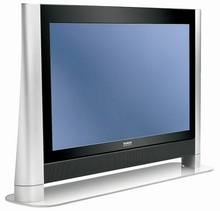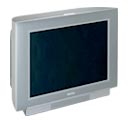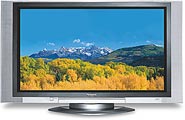How do I know if a TV is a HDTV?
Since the first HDTVs appeared in 1998, high-definition television has been on the mind of TV buyers. Moving from the analog TV system of the past 50 plus years, called NTSC, to the new digital TV system of today, called ATSC, requires many changes both on the part of the consumer and the television providers.Analog: An analog TV cannot display progressive-scan DVD or
HDTV. It can only show standard-definition programs such as those found on
regular TV, or cable--including digital cable.
Digital: A digital television, sometimes
called a DTV, can also display progressive-scan DVD, and possibly High Definition TV programming.
EDTV:
This stands for Enhanced-Definition TV, and usually it describes a
television that can display HDTV signals but doesn't have enough
resolution to do them justice. Most often it applies to plasma TVs and
denotes 852x480 pixels, not enough to be HDTV.
HDTV:
High-definition televisions, or HDTVs, can display standard TV,
progressive-scan DVD, and HDTV signals. HDTV will provide the best picture
given a High Definition source signal.
A digital TV must have specific characteristics in order to be a
HDTV.
Here is what to check for:
1) The most
obvious feature about a HDTV
is the screen size and shape. HDTVs will have a wide-screen, rectangle
shape, instead of the more square screen shape of old analog TVs.
The
screen should be almost twice as wide as it is tall. A good HDTV also has
a larger screen size than older TVs, with many in the 42 inch range or
larger, substantially larger than the 27 inch screen size of older analog
TV sets.
It's worth having a screen this big, because the increased
quality of progressive scan DVD and HDTV cable/satellite/off-air receivers
makes it worthwhile having the image this large. Many HDTVs are also super
thin, like Plasmas
and LCDs
which can be hung on a wall. But just because the TV is thin or has a flat
screen, does not necessarily make it a HDTV.
 |
 |
| HDTV | Standard analog TV |
2) Now let's get technical. In order to
qualify as a HDTV, the display must be at least 720 pixels by 1280 pixels.
This is not something you can determine by looking at the TV. You have to
do your homework here and research the specifications of the model you are
considering.
To be called "HDTV", a digital display must have a native resolution
of at least 1280 X 720 pixels. Just because a TV makes a picture with an
HDTV signal doesn't mean it actually produces this resolution on the
screen. You can also get higher native resolution displays such as
1920 X 1080 which are also High Definition TV. HDTV signals are 720p or
1080i (some 1080p are available on Blu-ray or HD-DVD). If your HDTV has a
native resolution of 768 X 1366, your HDTV will adjust the signal
according to the display requirements, either up converting or down
converting. Either way the HDTV will display both types of signals, 720p
or 1080i.
The 'p' means progressive
scanning while the 'i' means interlaced scanning. Progressive presents the
picture on the screen in one pass while interlaced takes two passes. With
the Blu-Ray and HD-DVD high-definition DVD players already out, you might
even consider a 1080p HDTV. Most people can't tell the difference between
720p and 1080i but your HDTV will make any conversion required to display
the signals properly according to your particular display's needs.
3) An HDTV must be "digital", inside and out. Your older TV from
years ago was analog and could never show digital signals directly. An HDTV
will have digital video cable connections such as DVI
or HDMI
for hooking up your progressive scan DVD player or digital cable box.
You
should have a ATSC
tuner built-in to the HDTV for over-the-air digital broadcasts. You may
also have a QAM tuner for digital cable and you may also have a CableCard
slot. (QAM stands for Quadrature Amplitude Modulation. Simply
put, this is the modulation used to transmit DTV via cable TV. It
differs from the 8-VSB modulation used in over-the-air broadcasts of
DTV. 8-VSB stands for 8-level Vestigial Sideband). For satellite TV
you need a satellite tuner/converter box to decode the satellite TV
signals.
DISPLAY TYPES - See HDTV Display Types
CRT - Direct view CRTs remain the lowest cost, although not the highest resolution. In the larger sizes, they get very heavy and are very deep.
LCD - Direct view LCD displays are becoming much more popular, higher quality and the prices are dropping. They have the advantage over CRT's of being bright, lower weight, and thin. Direct view LCD displays are becoming available in larger sizes, overtaking plasma in some cases with the same advantage of being very thin but using less power.
Plasma Display Panels - Plasma Displays have the advantage of being bright, thin, and available in large sizes (currently up to 103 in.). Their disadvantage is the weight and increased power consumption.
Rear Screen LCD and DLP projectors are rapidly replacing rear screen CRT because of their higher resolution and brightness, lighter weight, smaller box size, and decreasing manufacturing cost. They both need a light bulb to operate, but initial concerns are being overcome by extremely long-life metal halide lamps.
LCD and DLP projectors are now available in low-cost, high brightness, small size and low noise models for home theater installations. However, you need a room that can be made as dark as a movie theater in order for the pictures to look good.
DIGITAL TUNERS
Some digital displays do not include the digital tuner. Instead, you
have to buy a stand-alone set-top-box. This is changing with the FCC
mandate that all 36", 25" and 13" displays with analog tuners also include
a digital tuner by 2005, 2006 and 2007 respectively.
| Date | TV sizes that must include ATSC tuner* |
| March 1, 2006 | All TVs 25 inches or larger |
| March 1, 2007 | All TVs regardless of screen size |
Early digital tuners did not perform well in conditions of ghosting. Fortunately, the 5th generation decoder chips have improved this situation, and became available in the spring of 2005.
You can now get built-in digital tuners which can receive BOTH digital
cable signals and over-the-air digital transmissions. A security card
plugs into these boxes to enable various tiers of digital cable
programming. The Samsung SIR-T451 external digital tuner is an example of
a external digital tuner which will add high-def programming to any
HD-ready TV.
Over the air: Not all HDTVs come with a
built-in tuner (called digital or ATSC tuners) that can receive
high-definition programs over the air by simply connecting an antenna.
Sets that have them built in are called integrated HDTVs, and those
that don't are sometimes called HDTV ready or HDTV
compatible. If you buy an HDTV-ready set, you'll also need to
connect a separate tuner (or cable or satellite box) to watch
high-definition programming. External over-the-air HDTV tuners currently
cost around $120.
Cable and satellite: The FCC's plans for
ATSC tuners have nothing to do with HDTV over cable and satellite.
Subscribers to pay TV services can simply get a set-top box that tunes
HDTV channels, plug it into their HDTV-ready sets, and watch HDTV. Some
new HDTVs are digital cable ready (DCR), meaning they can tune
digital cable channels, including HDTV if the cable provider has HDTV
channels, without needing an external cable box. To use a DCR television,
you'll need to get an access card from your cable provider called a
CableCard. Unlike actual digital cable boxes, current DCR TVs can't do
video-on-demand, and you must pick up a phone if you want to order
pay-per-view programs. Using the card with some sets also means you can't
access the electronic program guide (EPG), although many new DCR HDTVs
include a third-party EPG, such as the TV Guide
system.
The WOW TEST
If you have never seen a true HDTV video image before on a HDTV, there is the WOW test. When you see true High Definition video on the screen of a HDTV you immediately know it because you think to yourself, WOW! that really looks good. The video is crisp, sharp and is often described as just like looking out a window on a bright sunny day.
AUDIO
HDTV signals often come with multi-channel sound as well as the video. Some shows have Dolby Digital 5.1 audio so you can surround yourself with six loudspeakers and enjoy the action even more.
BRAND NAMES
Stay with the top electronics brand names such as Sony, Samsung, Panasonic, LG, JVC, Sharp, Pioneer, Hitachi and avoid the no-name brands. In the long run you will be better off.
HDTV resolution
Resolution, or picture detail, is the main reason why HDTV programs look so good. The standard-definition programming most of us have watched on TV in the past has at most 480 visible lines of detail, whereas HDTV has as many as 1,080 lines. HDTV looks sharper and clearer than regular TV by a wide margin, especially on big-screen televisions. HDTV signals come in two different resolutions, called 1080i and 720p. One is not necessarily better than the other; 1080i has more lines and pixels, but 720p is a progressive-scan format that should deliver a smoother image that stays sharper during motion. Another format is also becoming more well-known: 1080p, which combines the superior resolution of 1080i with the progressive-scan smoothness of 720p.
Although resolution is the most talked about aspect of HDTVs, the most
important aspect of picture quality is contrast
ratio, the next important is color
saturation, and the next is color accuracy. Don't get too focused on
resolution alone.
Native resolution:
For
fixed-pixel displays: A fixed-pixel display is any HDTV or monitor
that uses pixels to produce an image, including flat-panel LCD and plasma
screens as well as rear-projection micro-displays and front projectors
that use DLP, LCD, or LCoS technology. Non-fixed-pixel displays,
namely direct-view and rear-projection CRTs, because they treat incoming
resolutions differently than their fixed-pixel cousins --since they don't
use discrete pixels, their specs are much more difficult to
determine.
All fixed-pixel displays have a native resolution
spec that tells you how many pixels the display actually has. Native
resolution is the absolute limit on the amount of detail you'll
see.
Fixed-pixel displays follow a few basic rules:
- No matter the resolution of the source material, whether VHS, DVD, or HDTV, a fixed-pixel display will always convert, or scale, it to fit its native resolution.
- If the incoming source has more pixels than the display's native resolution, you will lose some visible detail and sharpness, though often what you're left with still looks great.
- If the incoming source has fewer pixels than the native
resolution, you're not getting any extra sharpness from the television's
pixels.
Signal source is everything with HDTV. There are two main HDTV resolutions in use today by HD broadcasters and other sources: 1080i and 720p. One is not necessarily better than the other; 1080i has more lines and pixels, but 720p is a progressive-scan format that should deliver a smoother image that stays sharper during motion. Another format is also becoming better known: 1080p, which combines the superior resolution of 1080i with the progressive-scan smoothness of 720p. True 1080p content is extremely scarce, however, and none of the major networks have announced 1080p broadcasts. The term 1080p today appears mostly in reference to the displays' native resolution, not the source. None of the major networks have announced 1080p broadcasts. Plasma, LCD, LCoS and DLP TVs have a fixed number of pixels, known as native resolution, and the higher that number, the more detail you'll see. Naturally, higher-resolution fixed-pixel displays, such as 1080p sets with 1,920x1,080 pixels, cost more money.
| Source resolution | Resolution pixels | HDTV | Progressive scan |
Wide- screen |
Signal source |
| 1080p | 1,920x1,080 | Yes | Yes | Yes | Blu-ray; HD-DVD |
| 1080i | 1,920x1,080 | Yes | No | Yes | CBS, NBC, PBS |
| 720p | 1,280x720 | Yes | Yes | Yes | ABC, FOX, ESPNHD |
| 480p | 852x480 | No | Yes | Yes | prog-scan DVD |
| NTSC TV | Up to 480 lines | No | No | No | All |
Despite the obvious difference in pixel count, 720p and 1080i both look great. In fact, unless you have a very large television and excellent source material, you'll have a hard time telling the difference between any of the HDTV resolutions. It's especially difficult to tell the difference between 1080i and 1080p sources. The difference between DVD and HDTV should be visible on most HDTVs, but especially on smaller sets, it's not nearly as drastic as the difference between standard TV and HDTV.
HDTV display resolution
Now that we've considered the source, let's look at the televisions. As we mentioned above, all fixed-pixel HDTVs scale the incoming resolutions to fit the available pixels, throwing away information if they have fewer pixels and interpolating information if they have more pixels than the source.
| Native resolution ? | Commonly called ? | Meets definition of HDTV | TV types |
| 1,920x1,080 | 1080p | Yes | Flat-panel LCD; DLP, LCD, and LCoS projection; high-end plasma |
| 1,366x768 | 768p | Yes | Flat-panel LCD; 50-inch plasma |
| 1,280x720 | 720p | Yes | DLP, LCD, and LCoS projection |
| 1,024x768 | HDTV plasma | Yes | 37 and 42-inch plasma |
| 852x480 | EDTV plasma | No | 37 and 42-inch plasma |
| 640x480 | VGA | No | Small LCD TVs |
This is the number of physical pixels the television uses to produce a picture. You may notice that few of the resolutions in the table match the HDTV source resolutions exactly. That's mainly because TV makers find it more cost efficient to make panels with the pixel resolutions in the table and then scale the incoming sources to fit the screen. It's true that ideally you'd like to exactly match the incoming source with the display's native resolution, but it's much less important in HDTV than in, say, computer monitors. That's because scalers in HDTVs generally do a good job of converting the signals, and because most HDTV is in motion and seen from a distance, as opposed to static text seen up close.
All fixed-pixel displays are natively progressive-scan, meaning that even if the source is interlaced, they'll convert it to progressive-scan for display.
In the real world, it's difficult to tell the difference between native resolutions once you get into high-def. For example, despite the fact that a 37-inch LCD with 1,366x768 pixels has to throw away a good deal of information to display a 1080i football game on CBS, you'd be hard-pressed to see more detail on a similar 37-inch LCD with 1,920x1,080 resolution.
1080p
Once you get to high-def, the difference between resolutions becomes much more difficult to appreciate. Tests between two 50-inch rear-projection HDTVs, one with 720p resolution and the other with 1080p resolution, using the same 1080i source material, showed it was extremely difficult to see any difference. It becomes even more difficult at smaller screen sizes or farther seating distances--say, more than 1.5 times the diagonal measurement of the screen. A 37-inch 1080p LCD shows it is impossible to see the separation between horizontal lines at farther than 4 feet away.
Brightness on HDTV sets
Brightness on HDTV sets is often measured in cd/m2 or candela per square meter. This indicates how well you can view the TV in brighter lighting conditions. The higher the value the brighter the screen will be and the easier it will be to see in bright light conditions.
A typical TV set has a brightness of 350 cd/m2, and a new HDTV can be upwards of 1000 cd/m2.
Therefore if the room you will be watching your HDTV in is often bright you will benefit greatly from a higher cd/m2 TV set as it will help deliver a higher quality picture.
Brightness deals with the intensity of the light that one can see and is measured by candelas, as in candelas per meter squared or cd/m2. It can make a significant difference in a user's visual experience depending upon the environment and the content being viewed. If you watch TV in a sunlit room, you want a brighter screen than when you watch TV in a dark room. A typical CRT picture tube has an average rating of 350 cd/m2. The candela was based on an older unit, the candlepower, which was referenced to the luminous intensity of a "standard candle" of known composition. This was later replaced by a new unit, the candela, defined in terms of the black-body radiation emitted by 1/60 of 1 cm2 of platinum at its melting point.
LCD panel screens are lit with built-in fluorescent tubes above, beside and sometimes behind the LCD. This lamp, usually a Cold Cathode Fluorescent Lamp (CCFL), produces
little heat, is highly efficient, and has a long life span. A white diffusion panel behind the LCD redirects and scatters the light evenly to ensure a uniform display. This is known as a backlight. When that light goes out, you can barely see the image on the screen. This principle also applies to LCD and DLP projector and rear projector TV models.
Luminance is a photometric measure of the density of luminous intensity in a given direction. It describes the amount of light that is emitted from a particular area, and falls within a given solid angle.
Analog TV broadcast switch-off: In December 2005, the Senate passed a budget bill that calls for over-the-air television stations to cease their analog broadcasts by February 17, 2009. After that date, TVs and other gear with old-style NTSC tuners would be unable to receive over-the-air broadcasts. Part of the government's quandary is that the switch-off would cause many TVs to go dark and would deprive many lower-income viewers of their only source of television. To address this issue, lawmakers propose to subsidize converter boxes that would allow people to watch the new digital broadcasts on their old analog TVs. Further details on the transition to digital and the converter box subsidy are still being worked out but the proposed $40 voucher for qualified households may be available to buy a converter box.
See this for more information: Digital TV converter box, U.S. Govt program

